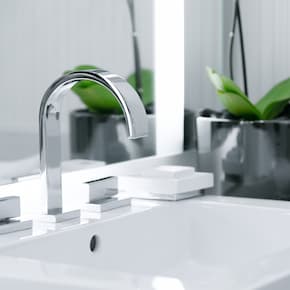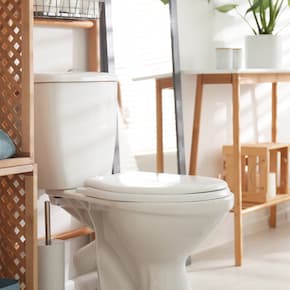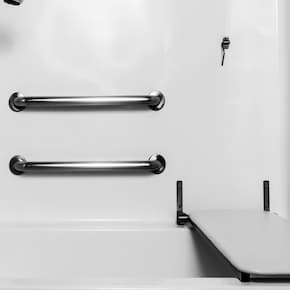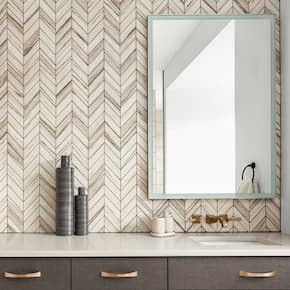How Much Does a Master Bathroom Remodel Cost?
Dreaming of a luxurious master bathroom retreat? A master bathroom remodel can be a significant investment, with costs typically ranging between $10,000 and $30,000. However, that number can vary depending on what you want.
This article will break down what these costs consist of, from materials to labor. We will also provide practical tips on how to save money during your renovation.
So, if you're curious about how to get the most bang for your buck, keep reading—we've got plenty of insights to offer!
Is Remodeling the Master Bathroom Worth it?

Remodeling the master bathroom can be a worthwhile investment for several reasons. Here are some key moments why remodeling can be a good solution:
- Increase Home Value: One of the main reasons people remodel their master bathroom is to increase the value of their home. A modern, updated bathroom can make a significant difference when selling a house. Potential buyers often look for updated bathrooms, and a remodeled master bathroom can be a strong selling point. This investment can offer a good return on the cost of remodeling the master bath when you sell your property.
- Improve Functionality: Over time, bathrooms can become less functional due to wear and tear or outdated layouts. Remodeling allows you to redesign the space to better suit your needs. This might include adding more storage, improving the layout, or installing new fixtures that make the bathroom more user-friendly. An improved bathroom can greatly enhance daily routines.
- Enhance Comfort and Luxury: A master bathroom remodel allows you to create a more comfortable and luxurious space. Upgrading to a spa-like environment with modern amenities such as a soaking tub, walk-in shower, or heated floors can provide a personal retreat within your home. These enhancements not only improve quality of life but also add a touch of luxury.
- Address Maintenance Issues: Older bathrooms often come with maintenance issues like leaks, mold, or outdated plumbing. Remodeling allows you to address these problems comprehensively. By replacing old pipes, fixing leaks, and updating fixtures, you can prevent future issues and reduce maintenance costs. This leads to a more efficient and problem-free bathroom.
- Personalization: Remodeling your master bathroom gives you the chance to personalize the space to your taste. Whether you prefer a modern, minimalist design or a more traditional look, you can choose the materials, colors, and fixtures that reflect your style. This personalization makes the bathroom a more enjoyable and unique part of your home.
- Improve Energy Efficiency: Updating your bathroom can also lead to better energy efficiency. Installing new, energy-efficient fixtures, such as low-flow toilets and LED lighting, can reduce water and electricity usage. This contributes to environmental preservation while simultaneously reducing expenses on utilities. An energy-efficient bathroom is a smart, long-term investment.
Bathtub Replacement
This includes removing the old bathtub, installing a new bathtub, and potentially changing the surrounding plumbing.
$3,000 - $10,000
Demolition
This involves removing the existing fixtures, flooring, walls, and anything else that's not being kept.
$500 - $2,000
Shower Replacement
Like a bathtub replacement, this involves removing the existing shower unit, installing a new shower, and potentially rerouting plumbing. Costs can vary depending on the complexity of the new shower design.
$2,000 - $8,000
Flooring
There are many flooring options available, from vinyl plank and laminate to luxury natural stone. The price will depend on the size of the bathroom and the material you choose.
$1,000 - $5,000
Lighting
Upgrading your bathroom lighting can make a big difference in both form and function. This could involve installing new light fixtures, adding dimmer switches, or incorporating task lighting around the mirror.
$500 - $2,000
Vanity Replacement
This includes removing the old vanity, installing a new vanity, and replacing the sink countertop and faucet. The cost can vary depending on the size and style of the new vanity.
$2,000 - $10,000
Countertops
New countertops can provide a fresh, clean look. Materials such as granite, quartz, or marble are popular for their durability and appearance.
$900 - $4,000
Toilet Replacement
This includes removing the old toilet and installing a new one.
$300 - $1,000
Ventilation
Replacing the bathroom fan is an important part of any remodel. A good ventilation system helps to remove moisture and prevent mold growth.
$800 - $2,000
Doors and Windows
Replacing or updating doors and windows can improve both privacy and energy efficiency. Frosted glass or energy-efficient windows are popular choices.
$500 - $3,000
Plumbing and Electrical Work
Updating plumbing and electrical systems ensures that everything functions smoothly and safely. This can include moving pipes or upgrading wiring.
$1,000 - $5,000
Walls and Paint
Refreshing the walls with new paint or tile can dramatically change the bathroom's look. Waterproof paint and tiles are essential for durability.
$300 - $2,000
What is the Investment Profitability After a Master Bathroom Remodel?
A well-executed master bathroom remodel can increase the market value of your home. Updated bathrooms are a key selling point for potential buyers. On average, homeowners can expect to recoup about 45% to 73% of the remodel costs when selling the property. This means that a $20,000 investment in a bathroom remodel could potentially increase your home’s value by $9,000 to $14,600.
Top Things Affecting the Average Master Bathroom Remodel Cost
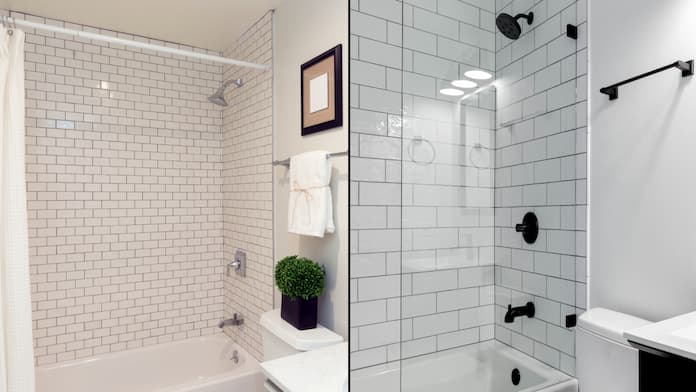
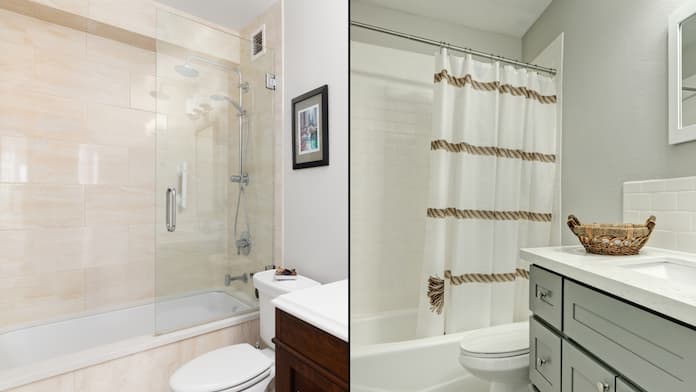
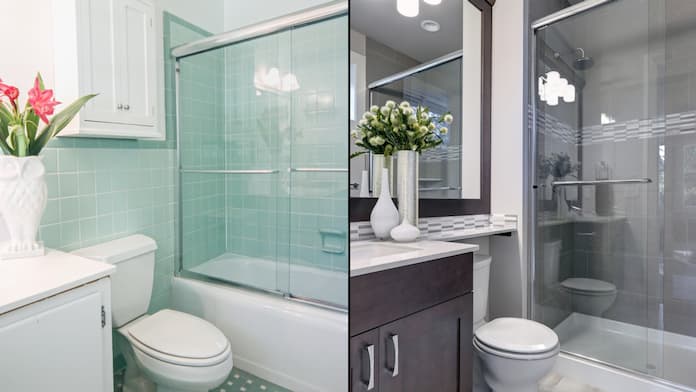
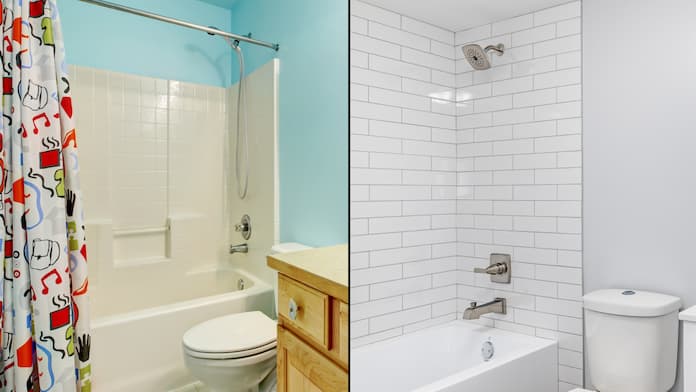
The final cost of your master bathroom remodel can vary greatly depending on several factors. Here’s a breakdown of the major ones:
- Scope of Work: This refers to the extent of the renovation. A simple refresh with new fixtures and finishes will cost significantly less than a complete gut renovation that involves changing the layout, moving plumbing, or altering electrical wiring.
- Size of the Bathroom: Larger bathrooms naturally require more materials and labor, driving up the cost.
- Material Selection: The type of materials you choose for everything from flooring and countertops to bathtubs and vanities will significantly impact the cost. High-end materials like marble or granite will be more expensive than ceramic tile or laminate countertops.
- Fixtures and Appliances: The choice of fixtures and appliances, such as sinks, toilets, bathtubs, and showers, affects the total cost. High-end or smart appliances can add to the expense.
- Demolition Costs: The amount of demolition required depends on your project's scope. Removing old tiles, fixtures, and walls can be time-consuming and add to the overall cost.
- Labor Rates: Labor costs vary depending on your location and the experience level of your contractor. Getting quotes from several contractors in your area will help you determine the average rates.
- Plumbing and Electrical Work: Moving plumbing lines or electrical wiring to accommodate a new layout or fixtures can be expensive.
- Permits and Inspections: Depending on your local building codes, you may need to obtain permits and have inspections conducted during the remodeling process. Take these expenses into account when planning your project's budget.
- Unexpected Issues: Sometimes unforeseen problems arise during demolition, such as outdated wiring or hidden water damage. These can add extra time and cost to renovate the master bath. Budget a contingency fund of 10-15% of your total project cost to cover unexpected issues.
Ways to Save Money When Remodeling the Master Bathroom
Remodeling a master bathroom can be costly, but there are several ways to save money without compromising on quality or style. Here are some practical tips to help you stay within budget:
- Plan and Budget Carefully: Start with a detailed plan and a clear budget. Decide on what needs to be done and prioritize essential updates. Adhering to your financial plan prevents unnecessary spending. Potential Savings: $500 to $2,000.
- Keep the Layout the Same: Changing the layout of the bathroom, such as moving plumbing or electrical lines, can increase your bathroom redesign cost. Keeping the existing layout can save significant costs on labor and materials. Potential Savings: $1,000 to $5,000.
- Do Some Work Yourself: If you have the skills, consider doing some of the work yourself, such as demolition, painting, or installing fixtures. It's best to entrust professionals with intricate jobs such as plumbing and electrical work. Potential Savings: $500 to $3,000.
- Shop for Sales and Discounts: Look for sales, discounts, and clearance items when purchasing materials and fixtures. Many stores offer significant discounts on high-quality items during sales events. Potential Savings: $200 to $2,000.
- Use Prefabricated Fixtures: Opt for prefabricated vanities, countertops, and showers instead of custom-made ones. Prefabricated options are often more affordable and can still look great. Potential Savings: $500 to $3,000.
- Refinish Instead of Replacing: Refinishing existing fixtures, such as bathtubs or cabinets, can be much cheaper than replacing them. This can give your bathroom a fresh look at a fraction of the cost. Potential Savings: $300 to $1,500.
- Choose Affordable Materials: Select budget-friendly materials that offer good quality. For example, laminate or ceramic tiles can be more affordable than marble or granite, yet still provide a stylish finish. Potential Savings: $500 to $4,000.
- Limit Tile Use: Tile can be expensive, especially high-end varieties. Use tile strategically, such as in high-impact areas like the shower, and opt for more affordable materials for the rest. Potential Savings: $200 to $2,000.
- Buy Used or Recycled Items: Consider purchasing used or recycled items for your remodel. Salvage yards, online marketplaces, and thrift stores can have high-quality fixtures and materials at lower prices. Potential Savings: $100 to $1,000.
- Hire a Skilled Handyman: For smaller tasks that don’t require a specialized contractor, hiring a skilled handyman can be more cost-effective. Ensure they are experienced and reliable. Potential Savings: $500 to $2,000.
- Get Multiple Quotes: Always get multiple quotes from contractors and compare them. This can assist you in discovering the most competitive rate for the services you require. Be sure to check references and reviews to ensure quality. Potential Savings: $500 to $2,000.
Should You Remodel the Master Bathroom Yourself or Hire a Professional?
Pros & Cons of Hiring a Professional Contractor
- Expertise and Experience: Professional contractors have the necessary skills, knowledge, and experience to handle all aspects of the remodel, from planning and design to execution.
- Quality Workmanship: With their expertise, contractors can ensure that the work is done correctly and to a high standard, reducing the risk of costly mistakes.
- Time-Efficient: Contractors have the resources and manpower to complete the project more quickly than a DIY approach.
- Safety and Compliance: Professionals are familiar with building codes and safety regulations, ensuring that the remodel meets all requirements.
- Higher Cost: Hiring a professional contractor typically comes with a higher ensuite renovation cost due to labor costs and overhead expenses.
- Less Control: You’ll have less direct control over the project since you’ll be relying on the contractor’s decisions and scheduling.
- Communication Challenges: Effective communication with the contractor is crucial to ensure that your vision is accurately translated into reality.
Pros & Cons of Doing It Yourself
- Cost Savings: By taking on the work yourself, you can save a significant amount of money on labor costs.
- Complete Control: You have full control over the project, allowing you to make decisions and adjustments as needed.
- Personal Satisfaction: There’s a sense of accomplishment and pride in completing the remodel with your own hands.
- Limited Skills and Knowledge: Unless you have extensive experience in construction and remodeling, you may lack the necessary skills and knowledge to tackle complex tasks.
- Increased Risk of Mistakes: Without professional expertise, there’s a higher risk of making costly mistakes that may require additional repairs or rework.
- Time-Consuming: DIY projects often take longer to complete, especially if you’re working on them in your spare time.
- Safety Concerns: Certain tasks, such as electrical or plumbing work, can be dangerous if not handled properly by a professional.
Permits and - Compliance: You’ll need to ensure that you comply with all relevant building codes and obtain the necessary permits, which can be a complex process.
How to Find a Master Bathroom Remodeling Specialist?
Finding a reputable master bathroom remodeling specialist in your area can be a breeze with Homebuddy.com. This convenient online platform connects you with pre-screened and qualified contractors in your area. You can easily browse contractor pages, view project photos and reviews, and request quotes directly through the website.
Benefits of Using Homebuddy.com:
- Convenience: The platform simplifies the search process, saving you time and effort.
- Local Expertise: Specialists are familiar with local codes and market conditions.
- Verified Professionals: Homebuddy.com often verifies credentials, ensuring you work with qualified professionals.
- Customer Reviews: Access to real customer reviews helps you make an informed choice
- Competitive Quotes: Comparing multiple quotes allows you to find the best value for your money.
Conclusion
Remodeling your master bathroom is a significant investment that not only enhances your daily living experience but can also boost your home’s value. By carefully planning your budget and understanding the factors that influence costs, you can achieve a beautiful and functional bathroom. Remember to consider permits, materials, and labor to ensure a successful renovation. With smart choices and a clear vision, your dream bathroom is within reach.
Frequently Asked Questions
- Can I remodel my master bathroom on a budget?
- Absolutely! Budget-friendly options include updating fixtures, repainting, and refinishing existing cabinets. Prioritizing what you change and shopping for deals can keep costs down.
- What are the most expensive elements of a master bathroom remodel?
- They are typically the labor costs, installation of new fixtures (tub, shower, etc.), countertops, and any structural changes or additions. Materials like high-end tile, stone, or custom cabinetry can also drive up the overall cost.
- How long does a master bathroom remodel take?
- A standard remodel usually takes between 2 to 3 weeks. However, if you’re planning a complete overhaul with structural changes, it could take up to 6 weeks or more.
- Do I need a permit to remodel my master bathroom?
- In most cases, yes. Structural changes and electrical or plumbing work typically require permits. Verify with the local construction regulatory body to guarantee adherence to all statutes.

